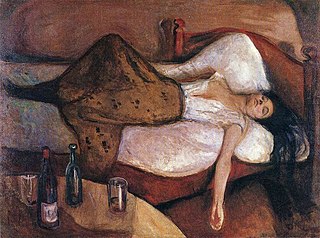Related Research Articles
Congener may refer to:

18-Methoxycoronaridine (18-MC) is a derivative of ibogaine invented in 1996 by the research team around the pharmacologist Stanley D. Glick from the Albany Medical College and the chemists Upul K. Bandarage and Martin E. Kuehne from the University of Vermont. In animal studies it has proved to be effective at reducing self-administration of morphine, cocaine, methamphetamine, nicotine and sucrose. It has also been shown to produce anorectic effects in obese rats, most likely due to the same actions on the reward system which underlie its anti-addictive effects against drug addiction.

A hangover is the experience of various unpleasant physiological and psychological effects usually following the consumption of alcohol, such as wine, beer, and distilled spirits. Hangovers can last for several hours or for more than 24 hours. Typical symptoms of a hangover may include headache, drowsiness, concentration problems, dry mouth, dizziness, fatigue, gastrointestinal distress, absence of hunger, light sensitivity, depression, sweating, nausea, hyper-excitability, irritability, and anxiety.

Coronaridine, also known as 18-carbomethoxyibogamine, is an alkaloid found in Tabernanthe iboga and related species, including Tabernaemontana divaricata for which it was named.

(–)-2-Methoxyethyl-18-methoxycoronaridinate (ME-18-MC) is a second generation synthetic derivative of ibogaine developed by the research team led by the pharmacologist Stanley D. Glick from the Albany Medical College and the chemist Martin E. Kuehne from the University of Vermont. In animal studies it has shown similar efficacy to the related compound 18-methoxycoronaridine (18-MC) at reducing self-administration of morphine and methamphetamine but with higher potency by weight, showing anti-addictive effects at the equivalent of half the minimum effective dose of 18-MC. Similarly to 18-MC itself, ME-18-MC acts primarily as a selective α3β4 nicotinic acetylcholine antagonist, although it has a slightly stronger effect than 18-MC as an NMDA antagonist, and its effects on opioid receptors are weaker than those of 18-MC at all except the kappa opioid receptor, at which it has slightly higher affinity than 18-MC.

(–)-18-Methylaminocoronaridine (18-MAC) is a second generation synthetic derivative of ibogaine developed by the research team led by the pharmacologist Stanley D. Glick from the Albany Medical College and the chemist Martin E. Kuehne from the University of Vermont.
In the alcoholic beverages industry, congeners are substances, other than the desired type of alcohol, ethanol, produced during fermentation. These substances include small amounts of chemicals such as methanol and other alcohols, acetone, acetaldehyde, esters, tannins, and aldehydes. Congeners are responsible for most of the taste and aroma of distilled alcoholic beverages, and contribute to the taste of non-distilled drinks. It has been suggested that these substances contribute to the symptoms of a hangover. Brandy, rum and red wine have the highest amount of congeners, while vodka and beer have the least.

In chemistry, congeners are chemical substances "related to each other by origin, structure, or function".
Alcohol congener analysis of blood and urine is used to provide an indication of the type of alcoholic beverage consumed. The analysis involves investigating compounds called congeners that give the beverage a distinctive appearance, aroma, and flavour, not including water and ethanol. The theory of discovering one's drinking habits has been investigated since the late 1970s, predominantly in Germany, for "hip-flask" defence cases (after-drinking). Alcohol congener analysis can play a crucial role in these cases where the driver is apprehended some time after a motor vehicle incident who, when returning a positive alcohol reading then claim that this is due to drinking an alcoholic beverage only after the incident. This traditional methodology for congener analysis has focused solely on the detection of fermentation by-product congeners that are found in all alcoholic beverages. By comparing the ratios of a set standard of congeners, the ingested alcoholic beverage type is proposed.

Onciderini is a tribe of longhorn beetles of the subfamily Lamiinae, they are prevalent across Europe in nations such as Turkey, and Finland.

Lochmaeocles is a genus of longhorn beetles of the subfamily Lamiinae, containing the following species:
Lochmaeocles consobrinus is a species of beetle in the family Cerambycidae. It was described by Dillon and Dillon in 1946.
Lochmaeocles sparsus is a species of beetle in the family Cerambycidae. It was described by Henry Walter Bates in 1880. It is known from Nicaragua, Honduras, Mexico, Costa Rica, and Panama.
Lochmaeocles vestitus is a species of beetle in the family Cerambycidae. It was described by Henry Walter Bates in 1885. It is known from Mexico.
Lochmaeocles cornuticeps is a species of beetle in the family Cerambycidae. It was described by Schaeffer in 1906.
Lochmaeocles cretatus is a species of beetle in the family Cerambycidae. It was described by Chemsak and Linsley in 1986. It is known from Mexico.
Lochmaeocles nigritarsus is a species of beetle in the family Cerambycidae. It was described by Chemsak and Linsley in 1986. It is known from Honduras and Mexico.
Lochmaeocles salvadorensis is a species of beetle in the family Cerambycidae. It was described by Franz in 1954. It is known from El Salvador.

Lochmaeocles sladeni is a species of beetle in the family Cerambycidae. It was described by Charles Joseph Gahan in 1903. It is known from Paraguay, Argentina, Brazil and Uruguay.
Lochmaeocles tessellatus is a species of beetle in the family Cerambycidae. It was described by James Thomson in 1868.
References
- ↑ BioLib.cz - Lochmaeocles congener. Retrieved on 8 September 2014.